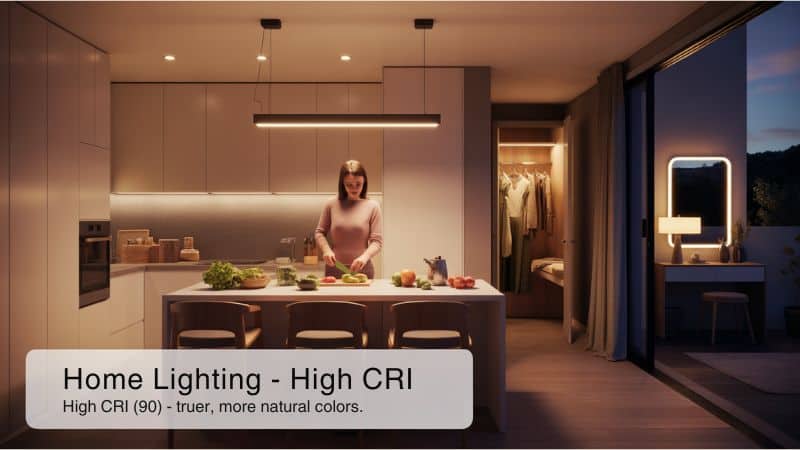Ever notice how some lights make colors pop while others leave everything looking kind of blah? That’s the magic of the Color Rendering Index, or CRI.
CRI is a scale from 0 to 100 that measures how accurately a light source reveals the true colors of objects compared to natural sunlight. A light with a CRI of 100 shows colors just like daylight would, while lower scores mean colors get more and more distorted.
So, what’s behind these numbers, and how do you pick the right light for your needs?
*If you don’t have time to read the whole guide, contact us directly to discuss your needs and get a tailored recommendation.
What is the Color Rendering Index (CRI)?
CRI measures how closely artificial light shows colors compared to natural sunlight, which gets a perfect 100. It’s a handy metric for figuring out if colors will look right under different lights.

Meaning of CRI
CRI basically asks: Do colors look the same under this light as they do outside on a sunny day? If they do, you’re looking at a light with excellent color rendering.
The scale runs from 0 to 100. Natural sunlight and old-school incandescent bulbs both hit 100. Most folks start noticing weird color shifts when CRI drops below certain points.
When CRI falls under 80, colors can look faded or just plain wrong. Ever tried to tell navy blue from black in bad lighting? Not fun.
CRI ratings of 80-90 are solid for most daily stuff. Above 90? That’s the gold standard for jobs where color really matters.
What CRI Stands For
CRI stands for Color Rendering Index. It’s a universal way to compare how well different lights show true colors.
“Rendering” is just a fancy word for how light reveals colors. And “index” means it’s a number you can use to compare options.
Manufacturers usually print CRI on the box or in the specs. Handy if you care about how your space looks.
Brief History of CRI
The Color Rendering Index came about in the 1960s, as lighting tech moved past simple incandescent bulbs. Suddenly, people noticed colors looked odd under new types of lights.
Researchers wanted a way to measure color quality that wasn’t just a guess. CRI gave manufacturers and buyers a standard to work with.
How CRI Works
To measure CRI, labs compare how eight standard test colors look under artificial light versus sunlight. It’s all about math—specifically, analyzing color differences—to land on that 0 to 100 score.
Scientific Principles Behind CRI
The idea is that sunlight is the “perfect” light, with a CRI of 100. Sunlight reveals every color in its truest form, so it’s the reference point.
There are eight test colors, chosen because they show up a lot in the real world. Each has unique spectral properties that help measure how a light source performs.
Scientists shine the test light on these samples and see how their colors change compared to sunlight. Our eyes see color through reflected wavelengths, and different lights emit different wavelengths—so objects can look off.
Lights with full spectral coverage get higher CRI scores. LEDs can have trouble with reds, making them look orange or dull.
How is CRI Measured?
Calculating CRI takes some serious measuring. A spectrophotometer checks the spectral power distribution of both the test light and the sunlight reference.
Each of the eight colors gets a score (R1 to R8). The main CRI value (Ra) is just the average of those. That’s usually what you’ll see on packaging.
They use the CIE 1960 UCS color space for these calculations. It keeps things consistent across labs and brands.
CRI Calculation Steps:
- Measure spectral output of the test light
- Compare it to a reference light with the same color temperature
- Work out the color differences for each sample
- Average the eight scores
- Apply corrections for the final CRI value
There are extended CRI tests too, covering R9 (saturated red) through R15. These give a deeper look at how a light source handles tricky colors.
Types and Categories of CRI
CRI comes in a few flavors. The standard system uses eight color samples, but there are extended versions with more samples for a fuller color assessment.

Different CRI Scales
The CRI scale goes from 0 to 100, kind of like a percentage. 100 means perfect color rendering, like sunlight or incandescent bulbs.
| CRI Scales | Features |
| Low CRI (0-70) | Colors look off, washed out, or just weird. Not great for anything where color matters. |
| Good CRI (70-90) | Decent for most uses. Many LEDs and fluorescents land here. |
| Excellent CRI (90-100) | Top-tier color fidelity. Think art galleries or photo studios. |
| *Each 10-point jump can make a noticeable difference in how colors look. Even if you’re not picky, you’ll probably feel it. | |
Standard vs. Extended CRI
Standard CRI (Ra) uses those eight test colors—mostly pastels you’d find in everyday life. It’s the basic measurement most products list.
Extended CRI adds more samples, R9 through R15, including strong reds, yellows, greens, and blues.
R9 (deep red) is a big deal. Some LEDs do fine on the standard test but flop on reds, which can make skin tones or warm colors look odd.
Extended CRI gives a clearer picture of light quality. If you’re in photography, retail, or healthcare, you’ll want to check those extra ratings.
Difference between CCT and CRI
CCT and CRI might sound similar, but they’re not measuring the same thing. Knowing the difference can make picking the right LED lights a lot easier.
CCT (Correlated Color Temperature) is about the color of the light itself. It tells you if the light looks warm or cool.
CCT uses Kelvin (K) as its unit. Lower numbers like 2700K mean warm, yellow-ish light. Go higher, like 6500K, and you get that bluish, daylight vibe.
CRI (Color Rendering Index) is all about how well colors show up under the light compared to sunlight. Again, it runs from 0 to 100, and 100 is as good as it gets.
| Aspect | CCT | CRI |
|---|---|---|
| What it measures | Color of light source | Color accuracy of objects |
| Scale | Kelvin (K) | 0-100 |
| Visibility | Immediately visible | Requires looking at illuminated objects |
You can spot CCT just by glancing at the bulb. Warm or cool, it’s obvious right away.
CRI is trickier—you’ve got to look at how things appear under the light. Sometimes colors seem faded, sometimes they’re vibrant, and that’s the CRI at work.
Both specs matter, but they don’t replace each other. A high CCT doesn’t mean colors will look good, and a high CRI doesn’t tell you the color tone.
For most homes, a CRI of 80 or above feels fine for everyday use.
Light Sources and CRI
Different lights give you different CRI values, depending on their tech. Sunlight is the gold standard, with a perfect CRI of 100.
Incandescent bulbs score high—usually 95-100. Their warm glow is pretty close to natural sunlight.
LED lights are all over the place when it comes to color rendering. Some have low CRI, making colors look flat or just a bit off.
| Light Source | Typical CRI Range |
| Incandescent | 95-100 |
| Halogen | 95-100 |
| LED | 70-95+ |
| Fluorescent | 50-90 |
| Mercury Vapor | 15-50 |
High-quality LEDs can hit CRI ratings of 90 and up, but they’re often more expensive thanks to the fancier materials and tech inside.
Fluorescent lights are unpredictable. Standard tubes might only reach 50-80 CRI, though some special types push past 90.
Your choice of light source really changes how colors show up in a space. Engineers and designers have to look at CRI when color matters.
CRI95 LED sources usually cost 10-20% more than CRI80 ones, mostly because of the extra tech needed for better color rendering.
What CRI Can’t Do
CRI has some real limitations that are worth knowing before you start picking out lights. The metric just doesn’t tell the whole story about light quality.
1. CRI doesn’t measure light intensity or brightness.
A light could have fantastic color rendering and still be way too dim—or blindingly bright—for what you need.
The traditional CRI system only looks at eight standard color samples. It completely ignores red colors, so it can miss some big color distortions, especially with skin tones or warm shades.
2. CRI can’t predict personal preferences for how colors should look.
Some folks just like warmer or cooler lighting, even if it isn’t technically “accurate.”
The metric doesn’t factor in color saturation or vividness. Two lights with the same CRI might make colors look totally different—one could be vibrant, the other washed out.
3. CRI scores above 90 don’t guarantee better performance than lights rated at 85.
Honestly, the scale starts to get a bit fuzzy at the high end.
Modern LED technology has exposed another flaw: CRI isn’t great at rating narrow-spectrum light sources, which are common in a lot of LED fixtures.
4. The metric can’t measure temporal effects like flicker or color stability over time.
A light might look great when new, but shift colors as it ages—CRI won’t tell you that.
CRI also fails to consider the specific colors that matter most for different uses. A light that’s perfect for showing off food might make fabrics or art look off.
Practical Application of CRI
Different spaces need different CRI levels. Residential areas usually get by with CRI around 80, but some commercial or industrial setups want higher numbers for their work.

Residential Lighting
Most home lighting works fine with CRI 80 or up. That’s enough for things like reading, cooking, or just living life.
- Kitchens and dining rooms do better with CRI between 85 and 90. Prepping meals and checking ingredients just feels easier when colors look right. No one wants veggies to look dull or raw meat to seem off.
- Bedrooms and living rooms are usually okay with CRI 80-85. You’re not inspecting art, just picking out clothes or relaxing, so you don’t need perfect color.
- Bathrooms should have at least CRI 85. Shaving, makeup, or anything where color matters—trust me, you notice when the lighting’s bad.
Commercial and Industrial Uses
Workplaces often push for CRI 90 or more. The quality of color can really influence the end result.
- Retail stores want high CRI so products look appealing. If the lighting’s off, customers might walk away.
- Photo and video studios need CRI above 95, no question. You can’t fix weird colors in post if the lighting messes them up in the first place.
- Healthcare facilities rely on high CRI for exams and procedures. Doctors and nurses need to see true colors to do their jobs safely.
- Manufacturing and quality control depend on good color rendering to spot defects and match colors exactly.







